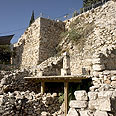
City of David
צילום: רון פלד
Israeli archaeologists find 2,000-year-old mansion linked to historic queen
Remains of mansion archaeologists believe likely belonged to Queen Helene of Adiabene unearthed during dig in east Jerusalem parking lot; building by far the largest and most elaborate structure discovered in the City of David area
Israeli archaeologists digging in an east Jerusalem parking lot have uncovered a 2,000-year-old mansion they believe likely belonged to Queen Helene of Adiabene, a minor but exceptional character in the city's history.
The remains of the building were unearthed just outside the walls of Jerusalem's Old City, underneath layers of later settlement that were themselves hidden until recently under the asphalt of a small parking lot. The dig site is in the Arab neighborhood of Silwan, built on a slope that houses the most ancient remnants of settlement in Jerusalem and is known to scholars as the City of David.
The building, which includes storerooms, living quarters and ritual baths, is by far the largest and most elaborate structure discovered by archaeologists in the City of David area, which was home 2,000 years ago almost exclusively to the city's poor. The contemporary Jewish historian Josephus Flavius, who penned detailed descriptions of Jerusalem, mentions only one wealthy family that lived there - the family of Queen Helene.
According to Josephus and Jewish texts, Helene was from a royal clan that ruled Adiabene, a region now in northern Iraq. Along with her family, she converted to Judaism and came to Jerusalem in the first half of the first century A.D.
Helene merited grateful mention in the Mishna, the written version of Judaism's oral tradition, where she is praised for her generosity to Jerusalem's poor and for making contributions to the Second Temple, the center of the Jewish faith, which was just a few hundred meters (yards) uphill from her house. She was buried in an elaborate tomb not far away.
'Structure destroyed with Jerusalem's destruction'
Today there is a downtown Jerusalem street named for her. There is a "high probability" that the mansion belonged to Helene's family, simply because no other building comes close to matching the historical description, Israel Antiquities Authority archaeologist Doron Ben-Ami said at a news conference announcing the discovery Wednesday.
Built when Jerusalem was capital of the Roman-ruled territory of Judea, the building was destroyed along with the temple and the rest of the city when Roman legions quelled a Jewish revolt nearly two millennia ago, he said. Diggers at the site discerned that the massive stones of the second floor had been purposely toppled onto the arches of the first, causing the house to collapse, he said, and in the ruins they found ceramic shards and coins dating to the time of the Jewish revolt against Rome.
"This amazing structure was destroyed with the destruction of Jerusalem in 70 A.D.," Ben-Ami said. Aren Maier, an archaeology professor at Israel's Bar-Ilan University, said Ben-Ami's hypothesis about the house's famous resident was a good one, because no similar building has yet been found anywhere nearby.
"If he did find a massive building of this kind, of course you can't say for sure, but it's certainly logical," Maier said.
Some of the most interesting archaeological finds in Jerusalem in recent years have come from the City of David dig, which has also become a popular tourist site. But the dig is controversial, because it's largely funded by a foundation affiliated with hard-line Jewish settlers that is also buying up Palestinian property in the neighborhood and moving Jewish families in.
Israel captured east Jerusalem from Jordan in the 1967 Mideast War. Palestinians see the eastern part of the city as capital of a future state.










